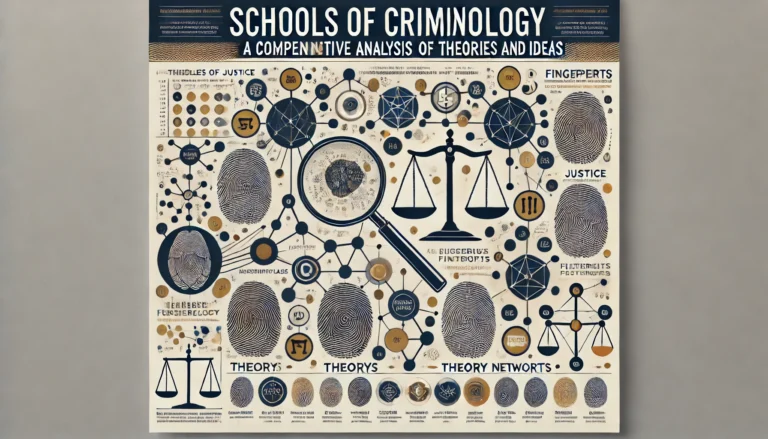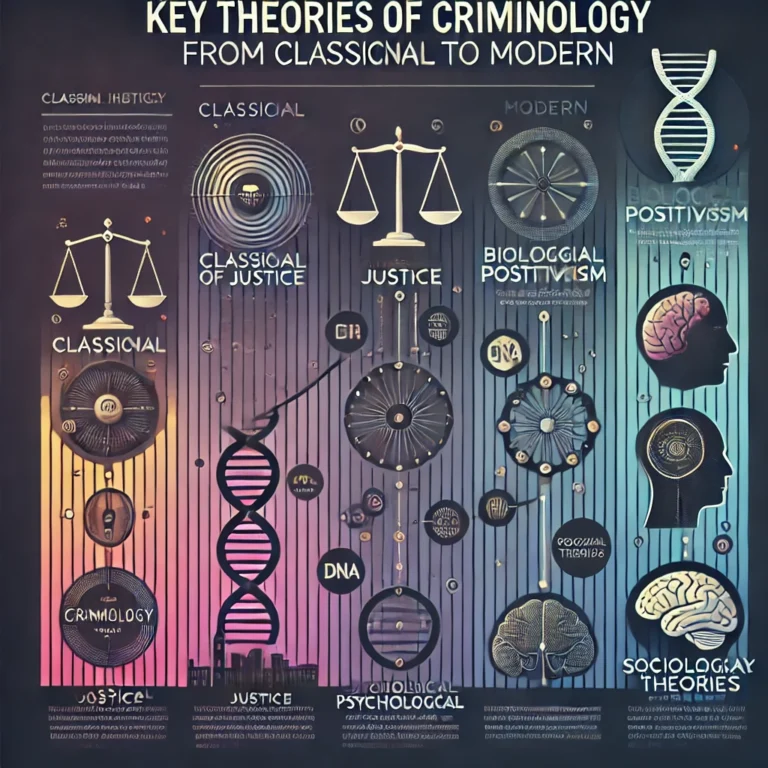Protective Psychology School in Criminology
Introduction
Criminology, the scientific study of crime and criminal behavior, has evolved through the years by incorporating insights from various disciplines, including psychology. Among the many approaches in criminology, the Protective Psychology School stands out for its emphasis on preventive measures and understanding psychological factors that contribute to criminal behavior. This school of thought is dedicated to exploring the underlying psychological mechanisms that drive individuals toward criminal acts and, more importantly, devising strategies to prevent these behaviors before they manifest.
In this article, we delve into the origins, principles, and applications of the Protective Psychology School in criminology. Additionally, we will examine its key contributors, critiques, and future potential, all while emphasizing the role of preventive psychological practices in modern criminology.
Historical Background
The Protective Psychology School emerged as a response to the limitations of punitive approaches in criminology. While traditional methods often focused on punishment and deterrence, psychologists began exploring how early interventions could mitigate criminal tendencies. This shift was influenced by broader developments in psychology and sociology, particularly during the early 20th century, when researchers like Sigmund Freud, Alfred Adler, and Carl Jung laid the foundation for understanding human behavior through psychological lenses.
During the mid-20th century, advancements in developmental psychology and behavioral science further shaped the Protective Psychology School. Studies on childhood development, such as those by Jean Piaget and Erik Erikson, highlighted how early life experiences significantly impact behavior. These insights became instrumental in crafting preventive measures aimed at reducing the likelihood of criminal behavior.
In criminology, the Protective Psychology School began gaining traction in the latter half of the 20th century as researchers sought alternatives to punitive systems. The integration of psychological theories into criminology allowed for a deeper understanding of the factors that contribute to crime, such as mental health issues, emotional trauma, and environmental stressors.
Key Principles of Protective Psychology
The Protective Psychology School is built upon several core principles, which collectively aim to reduce the occurrence of criminal behavior:
1. Early Intervention
Preventing criminal tendencies starts with early identification of risk factors. These include socioeconomic challenges, exposure to violence, and mental health issues. By addressing these factors during childhood or adolescence, the likelihood of criminal behavior can be significantly reduced.
2. Emphasis on Mental Health
Mental health is a cornerstone of the Protective Psychology School. It emphasizes the need for accessible mental health services to address psychological issues that may lead to criminal acts. Conditions such as depression, anxiety, and unresolved trauma are often linked to criminal behavior, making mental health intervention crucial.
3. Environmental Factors
The environment in which an individual grows up plays a critical role in shaping behavior. The Protective Psychology School advocates for creating supportive environments, such as stable family structures, quality education, and safe communities, to reduce criminal risk factors.
4. Rehabilitation over Punishment
Instead of focusing solely on punitive measures, this school promotes rehabilitation. It seeks to address the root causes of criminal behavior and provide individuals with the tools they need to reintegrate into society successfully.
5. Education and Awareness
Raising awareness about the psychological factors influencing criminal behavior is essential. Education campaigns and community programs can help individuals recognize and address these factors early.
Major Theorists and Contributions
Several theorists and researchers have significantly influenced the development of the Protective Psychology School. Their contributions have provided valuable insights into the psychological underpinnings of criminal behavior and effective preventive strategies.
Sigmund Freud
Freud’s psychoanalytic theories laid the groundwork for understanding the subconscious drivers of behavior. Concepts like repression, defense mechanisms, and unresolved childhood trauma have been integral in explaining why some individuals turn to crime.
Erik Erikson
Erikson’s stages of psychosocial development highlight the importance of resolving crises at various life stages. Failure to do so can lead to behavioral issues, including criminal tendencies. His work has informed early intervention strategies.
Albert Bandura
Bandura’s Social Learning Theory emphasizes the role of observation and imitation in behavior development. He demonstrated how exposure to violence or antisocial behavior in one’s environment could lead to criminal acts, underscoring the importance of positive role models.
John Bowlby
Bowlby’s Attachment Theory has been pivotal in understanding how early relationships impact behavior. His research on attachment styles has helped criminologists identify how insecure attachments can contribute to criminal tendencies.

Application in Criminology
The principles of the Protective Psychology School have been applied in various ways to prevent and address criminal behavior. Below are some key areas where this school has made a significant impact:
Community-Based Programs
Community initiatives such as mentorship programs, youth centers, and after-school activities are designed to provide at-risk individuals with positive influences and alternatives to criminal behavior.
School Interventions
Educational institutions play a vital role in implementing protective psychological strategies. Anti-bullying campaigns, counseling services, and behavioral intervention programs are examples of how schools can contribute to crime prevention.
Mental Health Services
Providing accessible mental health care is a crucial application of this school. Programs aimed at identifying and treating psychological issues early can prevent individuals from engaging in criminal acts.
Rehabilitation Programs
The Protective Psychology School emphasizes rehabilitation over incarceration. Programs that focus on skill-building, therapy, and emotional support aim to help offenders reintegrate into society and reduce recidivism rates.
Policy Development
Governments and policymakers have started to incorporate protective psychological principles into crime prevention strategies. For instance, investing in early childhood education, mental health services, and community development reflects this school’s influence.
Critiques and Limitations
While the Protective Psychology School offers numerous benefits, it is not without its challenges and criticisms:
1. Resource Intensiveness
Implementing protective psychological strategies requires substantial resources, including funding for mental health services, community programs, and educational initiatives.
2. Measurement of Effectiveness
Evaluating the success of preventive measures can be challenging. Unlike punitive approaches, which have tangible outcomes (e.g., incarceration rates), the impact of prevention is harder to quantify.
3. Overemphasis on Psychology
Some critics argue that this school places too much emphasis on psychological factors, potentially neglecting other important aspects, such as socioeconomic conditions or systemic inequalities.
4. Resistance to Change
Traditional punitive systems are deeply ingrained in many societies, making it difficult to shift toward a preventive approach. Cultural and institutional resistance can hinder the adoption of Protective Psychology principles.
Future Directions
As society continues to evolve, so too must the Protective Psychology School. Future developments may include:
Integration with Technology
Advancements in artificial intelligence and data analysis could enhance the ability to identify at-risk individuals and develop tailored interventions.
Cross-Disciplinary Approaches
Collaboration with fields like sociology, neuroscience, and criminal justice can provide a more comprehensive understanding of criminal behavior and effective prevention strategies.
Global Implementation
Expanding protective psychological strategies to underserved regions and communities worldwide can help address global crime challenges.
Focus on Equity
Ensuring that preventive measures are accessible to all, regardless of socioeconomic status, is essential for maximizing their effectiveness.
Conclusion
The Protective Psychology School in criminology represents a paradigm shift from punishment to prevention. By addressing the psychological factors that contribute to criminal behavior, this school offers a holistic approach to reducing crime and promoting societal well-being. Despite its challenges, the Protective Psychology School holds immense potential for shaping the future of criminology and fostering safer, healthier communities worldwide.
By continuing to explore and refine these principles, researchers, policymakers, and practitioners can make significant strides in understanding and preventing criminal behavior, ensuring a more just and equitable society for all.







